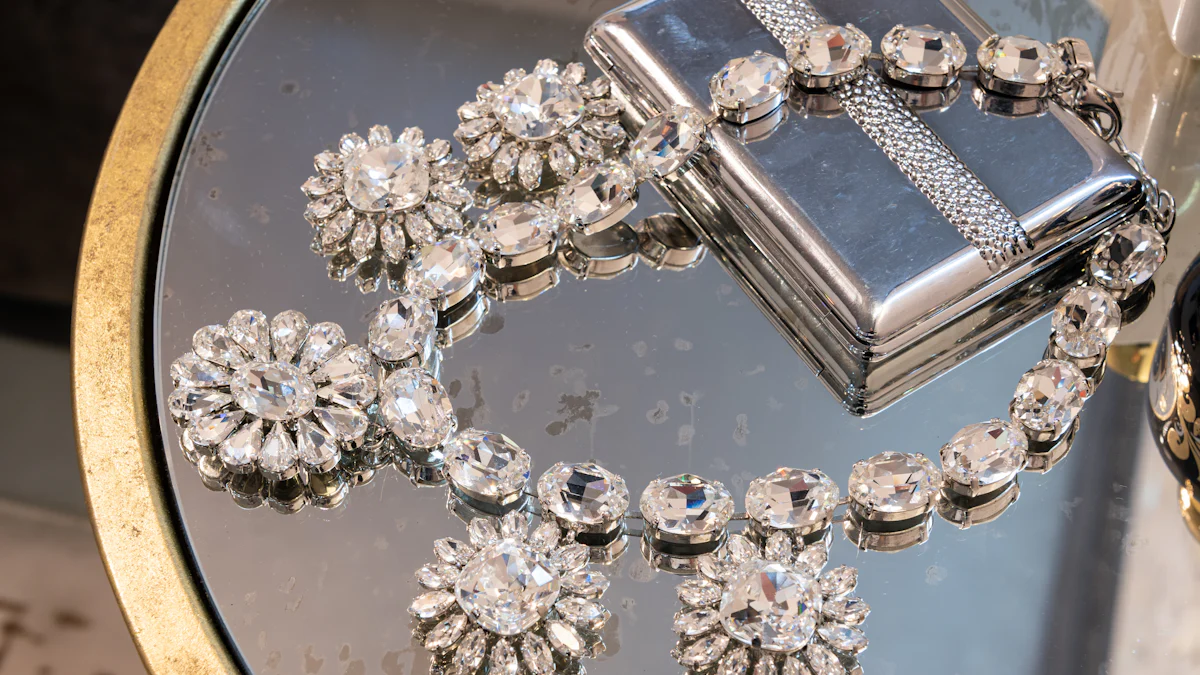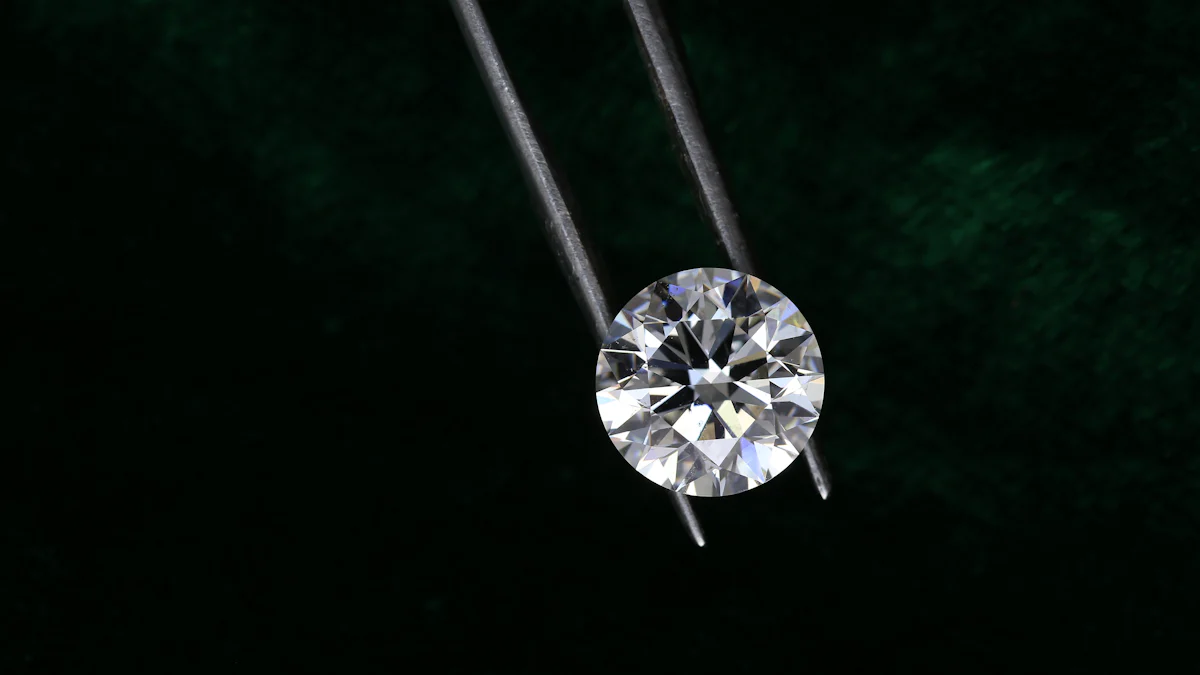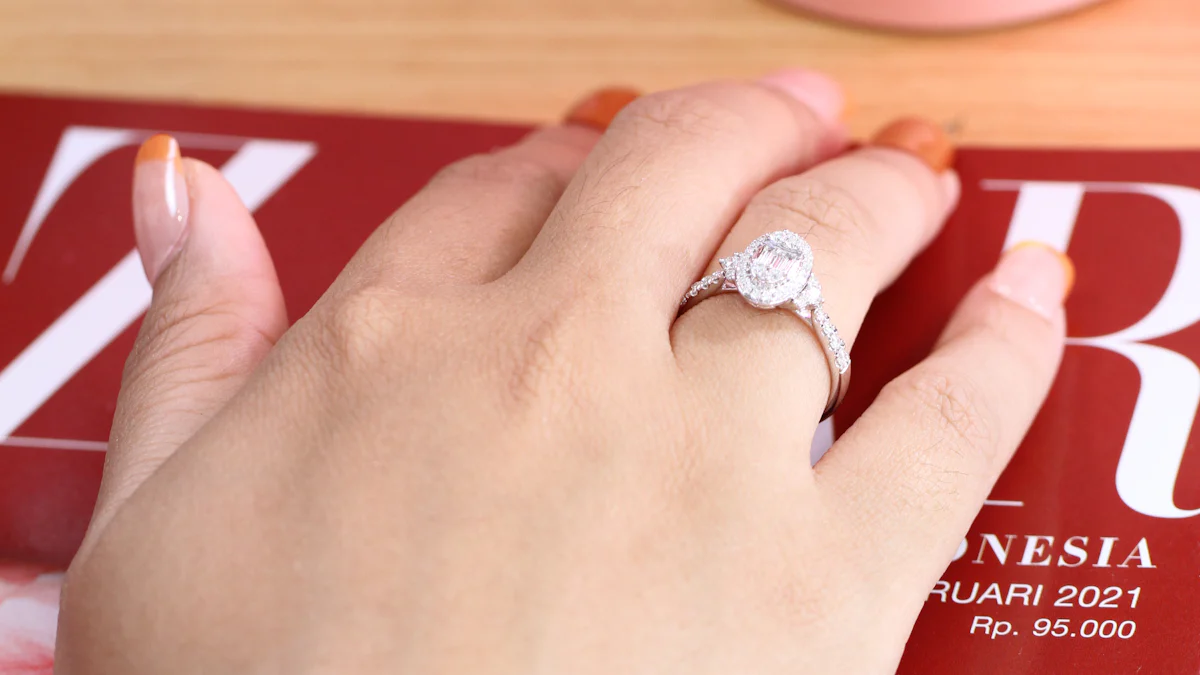Average Cost of 1 Carat Diamond Explained

When you explore the world of diamonds, the cost of 1 carat diamond often ranges from $1,800 to $12,000. This wide range reflects various factors that influence pricing. The 4 Cs—cut, color, clarity, and carat—play a significant role in determining the cost of a 1 carat diamond. Additionally, the shape of the diamond and whether it is natural or lab-grown can impact the price. For instance, a lab-created diamond might cost around $1,000, while a similar natural diamond could be priced at $4,200. Understanding these elements helps you make informed decisions when purchasing a 1 carat diamond ring.
Understanding the 4 Cs and Their Impact on Cost

When you delve into diamond pricing factors, the 4 Cs—cut, color, clarity, and carat—serve as the foundation. Each of these elements significantly influences the cost of a 1 carat diamond.
Cut
How cut quality affects price
The cut of a diamond determines how well it reflects light, which directly impacts its brilliance. A well-cut diamond sparkles more and thus commands a higher price. You might find that diamonds with excellent cuts are more expensive than those with good or fair cuts. The precision of the cut can make a diamond appear larger and more vibrant, enhancing its value.
Popular cuts and their cost implications
Popular diamond cuts include round, princess, and emerald. Round cuts often cost more due to their high demand and the precision required in cutting. In contrast, fancy cuts like pear or marquise might be less expensive. When choosing a cut, consider both your budget and the desired appearance of the diamond.
Color
Color grading and its impact on price
Diamonds are graded on a color scale from D (colorless) to Z (light yellow or brown). Colorless diamonds are rare and thus more valuable. As you move down the scale, the presence of color increases, which can lower the price. A diamond's color grade can significantly affect its cost, with colorless diamonds fetching premium prices.
Common color grades for 1-carat diamonds
For a 1-carat diamond, common color grades range from G to J. These grades offer a balance between quality and affordability. You might notice that diamonds in this range appear nearly colorless to the untrained eye, making them a popular choice for many buyers.
Clarity
Clarity grades and pricing
Clarity refers to the presence of internal or external imperfections, known as inclusions and blemishes. Diamonds are graded from Flawless (no inclusions visible under 10x magnification) to Included (inclusions visible to the naked eye). Higher clarity grades increase a diamond's price. However, many inclusions are microscopic and do not affect a diamond's beauty.
Balancing clarity with budget
When balancing clarity with your budget, consider that slight inclusions often go unnoticed without magnification. Opting for a diamond with a slightly lower clarity grade can save money without sacrificing visual appeal. Prioritize what matters most to you, whether it's clarity, size, or another factor.
Carat
Carat weight and its influence on cost
Carat weight significantly impacts a diamond's price. As the carat weight increases, the price per carat also rises. This is because larger diamonds are rarer and more desirable. You might notice that a 1-carat diamond costs more than two 0.5-carat diamonds combined. This price increase reflects the rarity and prestige associated with larger stones. When considering carat weight, balance your desire for size with your budget. A slightly smaller diamond can offer substantial savings without sacrificing beauty.
Comparing 1-carat diamonds to other sizes
When comparing 1-carat diamonds to other sizes, you will find distinct differences in price and appearance. A 1-carat diamond often serves as a benchmark for size and value. Smaller diamonds, such as 0.75-carat stones, provide a more budget-friendly option while still offering significant sparkle. Larger diamonds, like 1.5 or 2 carats, command higher prices due to their rarity and visual impact. Consider your personal preferences and financial constraints when choosing the right size. A well-chosen 1-carat diamond can offer an excellent balance of size, brilliance, and affordability.
The Impact of Diamond Shape on Cost

Popular Diamond Shapes
When selecting a diamond, the shape plays a crucial role in determining its cost. Round diamonds are the most popular and often the most expensive due to their high demand and the precision required in cutting them. They offer maximum brilliance and sparkle, making them a favorite choice for many buyers.
Round vs Fancy Shapes
Round diamonds typically command higher prices compared to fancy shapes. Fancy shapes include options like princess, emerald, pear, and marquise. These shapes can be up to 25% less expensive than round diamonds. The lower cost of fancy shapes makes them an attractive option for those seeking unique designs without breaking the bank.
Cost Differences Among Shapes
The cost differences among diamond shapes arise from both demand and the cutting process. Round diamonds require more of the rough stone to be cut away, which increases their price. In contrast, fancy shapes often retain more of the original stone, resulting in lower costs. For example, a 1-carat round diamond might cost significantly more than a 1-carat princess cut diamond of similar quality.
Choosing a Shape for Your Budget
Selecting the right diamond shape can help you stay within your budget while still achieving the desired aesthetic.
Shape Recommendations for Cost Savings
If you're looking to save money, consider opting for fancy shapes. Shapes like the princess cut or cushion cut offer excellent brilliance at a lower price point. Additionally, the oval and pear shapes provide a larger appearance for their carat weight, giving you more visual impact for your investment. By choosing a less traditional shape, you can enjoy a beautiful diamond without exceeding your budget.
Natural vs Lab-Grown Diamonds: Cost Considerations
When considering diamond purchases, you will encounter both natural and lab-grown options. Each type has distinct cost implications that can influence your decision.
Differences in Cost
Price comparison between natural and lab-grown
Natural diamonds typically command higher prices than lab-grown diamonds. The formation process of natural diamonds takes millions of years, contributing to their rarity and value. In contrast, lab-grown diamonds are created in controlled environments, allowing for more efficient production. This efficiency often results in lower prices for lab-grown diamonds. For example, a 1-carat natural diamond might cost around $4,200, while a similar lab-grown diamond could be priced at approximately $1,000. This significant price difference makes lab-grown diamonds an attractive option for budget-conscious buyers.
Market trends for lab-grown diamonds
The market for lab-grown diamonds has seen substantial growth in recent years. As technology advances, the quality and availability of lab-grown diamonds continue to improve. Many consumers appreciate the ethical and environmental benefits associated with lab-grown diamonds, further driving demand. This increased interest has led to more competitive pricing, making lab-grown diamonds an appealing choice for those seeking value without compromising on quality.
Perception and Value
How origin affects perceived value
The origin of a diamond can significantly impact its perceived value. Natural diamonds often carry a sense of prestige and tradition, which can enhance their appeal. Many people view them as timeless symbols of luxury and status. On the other hand, lab-grown diamonds offer a modern alternative that appeals to environmentally conscious consumers. While they may lack the historical allure of natural diamonds, lab-grown options provide an ethical and affordable choice. Ultimately, your personal values and preferences will guide your decision between natural and lab-grown diamonds.
Importance of Certification in Determining Cost
When purchasing a diamond, certification plays a crucial role in determining its cost and ensuring its authenticity. A certified diamond provides you with a detailed report of its characteristics, helping you make an informed decision.
Trusted Grading Labs
GIA, AGS, and Other Reputable Labs
Several reputable grading labs provide diamond certifications. The Gemological Institute of America (GIA) and the American Gem Society (AGS) are among the most trusted. These labs offer unbiased assessments of a diamond's quality, including its cut, color, clarity, and carat weight. Choosing a diamond certified by these labs ensures you receive a stone that meets high standards.
Why Certification Matters
Certification matters because it verifies the diamond's quality and authenticity. It protects you from overpaying for a diamond that doesn't meet the claimed specifications. A certified diamond gives you confidence in your purchase, knowing that an independent expert has evaluated it. This assurance is especially important when comparing natural and lab-grown diamonds, as prices can vary significantly.
Reading a Diamond Certificate
Key Information to Look For
When you receive a diamond certificate, pay attention to several key pieces of information:
- Cut Grade: Indicates how well the diamond has been cut, affecting its brilliance.
- Color Grade: Ranges from D (colorless) to Z (light yellow or brown), impacting the diamond's appearance and value.
- Clarity Grade: Describes the presence of inclusions or blemishes, influencing the diamond's visual appeal.
- Carat Weight: Measures the diamond's size, directly affecting its price.
Understanding these details helps you assess the diamond's value and ensures you make a purchase that aligns with your expectations and budget.
Price Scenarios for Different Budgets
Budget-Friendly Options
Tips for Finding Affordable Diamonds
When searching for affordable diamonds, focus on the 4 Cs—cut, color, clarity, and carat. Prioritize the cut, as it affects the diamond's brilliance the most. Opt for a slightly lower color grade, such as G to J, which still appears nearly colorless to the untrained eye. Consider diamonds with slight inclusions that are not visible without magnification. These choices can significantly reduce costs without compromising beauty.
- Shop Online: Online retailers often offer competitive prices compared to brick-and-mortar stores. They have lower overhead costs, allowing them to pass savings on to you.
- Look for Sales: Keep an eye out for sales events or discounts, especially during holidays or special promotions. These can provide excellent opportunities to purchase quality diamonds at reduced prices.
- Consider Lab-Grown Diamonds: Lab-grown diamonds offer a cost-effective alternative to natural diamonds. They possess the same physical and chemical properties but come at a fraction of the price.
Compromises to Consider
While seeking budget-friendly options, you may need to make some compromises. Accepting a lower clarity grade can save money, as many inclusions are microscopic and do not affect the diamond's appearance. Choosing a fancy shape instead of a round one can also reduce costs. Remember, the goal is to find a balance between quality and affordability that suits your preferences.
Mid-Range and Luxury Options
What to Expect in Higher Price Ranges
In the mid-range and luxury segments, you can expect diamonds with higher grades in the 4 Cs. These diamonds often feature excellent cuts, near-colorless grades, and higher clarity levels. The carat weight may also increase, offering larger and more impressive stones.
- Mid-Range Diamonds: Typically, these diamonds offer a balance of quality and size. You might find diamonds with very good cuts, color grades from D to F, and clarity grades like VS1 or VS2. These diamonds provide a noticeable upgrade in brilliance and appearance.
- Luxury Diamonds: In this category, diamonds often boast the highest grades in all aspects. Expect flawless or internally flawless clarity, colorless grades, and exceptional cuts. These diamonds are rare and command premium prices, reflecting their superior quality and prestige.
Investing in mid-range or luxury diamonds ensures you receive a stone that stands out in terms of beauty and value. Whether you choose a budget-friendly option or a luxury diamond, understanding the factors that influence price helps you make an informed decision.
Tips for Buying Diamonds on a Budget
Strategies for Saving
Prioritizing the 4 Cs
When buying diamonds on a budget, focus on the 4 Cs: cut, color, clarity, and carat. Prioritize the cut, as it affects the diamond's brilliance the most. A well-cut diamond sparkles more, even if it has a lower color or clarity grade. Choose a slightly lower color grade, such as G to J, which still appears nearly colorless to the untrained eye. Consider diamonds with slight inclusions that are not visible without magnification. These choices can significantly reduce costs without compromising beauty.
Shopping during sales or online
Shopping during sales or online can lead to significant savings. Online retailers often offer competitive prices compared to brick-and-mortar stores. They have lower overhead costs, allowing them to pass savings on to you. Keep an eye out for sales events or discounts, especially during holidays or special promotions. These can provide excellent opportunities to purchase quality diamonds at reduced prices. Additionally, consider lab-grown diamonds, which offer a cost-effective alternative to natural diamonds. They possess the same physical and chemical properties but come at a fraction of the price.
Avoiding Common Pitfalls
Recognizing misleading deals
When shopping for diamonds, stay vigilant to avoid misleading deals. Some sellers might advertise diamonds at seemingly low prices, but these stones may have poor quality in one or more of the 4 Cs. Always request a certification from a reputable grading lab, such as the Gemological Institute of America (GIA). This certification ensures the diamond's authenticity and quality. Be cautious of deals that seem too good to be true, as they often involve hidden compromises. By understanding the factors that influence diamond prices, you can make informed decisions and avoid common pitfalls.
Understanding the cost of 1 carat diamond involves examining several key factors. The 4 Cs—cut, color, clarity, and carat—are crucial in determining a diamond's value. Additionally, the shape and origin, whether natural or lab-grown, significantly influence the price. To make a wise purchase, you must balance quality with budget. Consider factors like shape and inclusions to avoid overspending. By doing so, you can find a diamond that meets your aesthetic desires without exceeding your financial limits.
FAQ
What factors influence the price of a 1 carat diamond?
Several factors impact the price of a 1 carat diamond. The 4 Cs—cut, color, clarity, and carat weight—are primary determinants. Additionally, the diamond's shape, certification, and market demand play significant roles. For instance, round diamonds often cost more due to their popularity and the precision required in cutting them.
How does the cut of a diamond affect its price?
The cut quality of a diamond significantly influences its price and beauty. A well-cut diamond reflects light brilliantly, enhancing its sparkle and value. Diamonds with excellent cuts command higher prices compared to those with fair or good cuts. The precision of the cut can make a diamond appear larger and more vibrant.
Why are round diamonds more expensive than other shapes?
Round diamonds typically cost more because they are in high demand and require more of the rough stone to be cut away. This process increases their price. In contrast, fancy shapes like princess or pear retain more of the original stone, resulting in lower costs. The popularity and cutting process of round diamonds contribute to their higher price.
Are lab-grown diamonds cheaper than natural diamonds?
Yes, lab-grown diamonds are generally more affordable than natural diamonds. The controlled environment in which they are created allows for efficient production, leading to lower prices. For example, a 1-carat lab-grown diamond might cost around $1,000, while a similar natural diamond could be priced at $4,200.
What role does certification play in diamond pricing?
Certification verifies a diamond's quality and authenticity, impacting its price. Reputable grading labs like the Gemological Institute of America (GIA) provide unbiased assessments of a diamond's characteristics. A certified diamond ensures you receive a stone that meets high standards, protecting you from overpaying for a diamond that doesn't meet the claimed specifications.
How can I find affordable diamonds?
To find affordable diamonds, focus on the 4 Cs. Prioritize the cut for brilliance, and consider slightly lower color grades like G to J. Opt for diamonds with slight inclusions that aren't visible without magnification. Shopping online or during sales can also lead to significant savings. Lab-grown diamonds offer a cost-effective alternative to natural ones.
What should I look for in a diamond certificate?
When reviewing a diamond certificate, pay attention to key information such as:
- Cut Grade: Indicates the diamond's brilliance.
- Color Grade: Ranges from D (colorless) to Z (light yellow or brown).
- Clarity Grade: Describes inclusions or blemishes.
- Carat Weight: Measures the diamond's size.
Understanding these details helps you assess the diamond's value and ensures your purchase aligns with your expectations.
How do market conditions affect diamond prices?
Market conditions, including supply and demand, significantly influence diamond prices. Economic factors like inflation can cause prices to rise. Changes in consumer preferences and technological innovations in diamond mining also impact pricing trends. Staying informed about market conditions can help you make a wise purchasing decision.
Can I save money by choosing a fancy-shaped diamond?
Yes, choosing a fancy-shaped diamond can save you money. Fancy shapes like princess, emerald, or marquise often cost up to 25% less than round diamonds. These shapes retain more of the original stone during cutting, resulting in lower costs. Opting for a fancy shape allows you to enjoy a unique design without exceeding your budget.
What are the benefits of buying a lab-grown diamond?
Lab-grown diamonds offer several benefits. They are more affordable than natural diamonds and possess the same physical and chemical properties. Many consumers appreciate their ethical and environmental advantages. As technology advances, the quality and availability of lab-grown diamonds continue to improve, making them an appealing choice for budget-conscious buyers.
See Also
What Is the Price of a 2 Carat Lab Diamond
Essential Elements That Influence Diamond Ring Costs
What Does a 3 Carat Lab Diamond Cost

